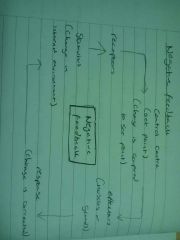![]()
![]()
![]()
Use LEFT and RIGHT arrow keys to navigate between flashcards;
Use UP and DOWN arrow keys to flip the card;
H to show hint;
A reads text to speech;
34 Cards in this Set
- Front
- Back
- 3rd side (hint)
|
Define Homeostasis. |
The maintenance of a constant internal environment, regulated by a negative feedback loop through the use of hormones. |
|
|
|
Draw the negative feedback loop. |

|
|
|
|
Describe how blood glucose is maintained. |
Glucose is stored as glycogen. When the body needs more glucose, the hormone glucagon converts glycogen to glucose. When the body needs less glucose, the hormone insulin converts glucose to glycogen. |
The three G's. |
|
|
How is temperature controlled? |
Increased/decreased respiration. Vasoconstriction/Vasodilation. Sweating/shivering. |
By the hypothalamus. Which makes the body... |
|
|
Two examples of negative feedback loops. |
Blood glucose. Temperature control. |
|
|
|
Give two examples of positive feedback loops. |
Oxytocin - for contractions in pregnancy. Clot formation - platelets attract more platelets to the cut site. |
|
|
|
Role of the kidney? |
-Excrete nitrogenous waste. -Osmoregulation. (Controls water potential) |
There are two. |
|
|
Equation for the production of urea? |
Amino acid → alpha keto acid + ammonia → urea. NH2CHRCOOH → CROCOOH + NH3 → CO(NH2). |
Breakdown of proteins. |
|
|
What does the nephron filter? |
-Micro nutrients -Vitamins -Ions -Water |
|
|
|
Define positive feedback. |
As one increases, the other increases. Vice versa. |
|
|
|
Define negative feedback. |
As one increases, the other decreases. And vice versa. |
|
|
|
What is regulated by homeostasis? |
- water levels. - temperature. - nitrogenous waste levels. - glucose levels. |
|
|
|
What do the Afferent arterioles do? |
Supply the blood to the nephron. |
|
|
|
What do the efferent arterioles do? |
Take away filtered blood from the glomerulus. |
|
|
|
What is the glomerulus? |
A ball of capillaries that filters the blood into the nephron. |
|
|
|
What does the Bowmen's capsule do? |
Captures the blood from the glomerulus. |
|
|
|
What happens in the proximal convoluted tubule? |
Selective reabsorption |
|
|
|
What happens in the loop of Henle? |
-The descending limb is permeable and allows osmosis to occur, drawing the water out to the interstitial fluid. - At the bottom of the loop, the fluid is very concentrated as a lot of water has diffused out of the descending limb. -Sodium and chloride ions are actively pumped out of the ascending limb. -The ions accumulate in the interstitial fluid. Water tries to diffuse out of the ascending limb, however it is impermeable. -The fluid surrounding the bottom of the loop - in the medulla - is also concentrated, due to the accumulation of sodium and chloride ions.
- The fluid is very dilute at the top of the ascending limb. - This fluid empties into the collecting duct, which pass through the highly concentrated medulla. - ADH affects the permeability of the duct, allowing for osmosis to occur, drawing water from the duct. |
|
|
|
What happens in the Distal convoluted tubule? |
Water is reabsorbed as the body needs it. |
|
|
|
What happens in the collecting duct? |
Takes the fluid to the ureter. Its permeability is affected by ADH, and water is reabsorbed to the body here. |
|
|
|
What are the three layers of the Bowman's capsule? |
Wall of capillaries Basement membrane Wall of bowmans capsule ( podocytes) |
|
|
|
What forms glomerule filtrate? |
Water Glucose Urea Salts Amino acids |
|
|
|
Define Ultrafiltration. |
Filtration under high pressure. The basement membrane prevents large molecules from being taken out the blood. |
|
|
|
How much of the blood from the heart goes to the kidney? |
20% |
|
|
|
How do you find percentage filtrate? |
(Produced filtrate / received blood) X 100 |
|
|
|
How do you find the volume of blood leaving the glomerulus? |
Received blood - produced filtrate. |
|
|
|
What is selective reabsorption? |
Process where useful products are reabsorbed back into the blood as the filtrate flows through the nephron. |
|
|
|
Which is the longest and widest part of the nephron? |
Proximal convoluted tubule. |
PCT. |
|
|
What is reabsorbed from the PCT? |
All glucose All amino acids Most water Some urea Most sodium/ chloride ions |
|
|
|
What are the adaptions of the PCT? |
Microvilli on cuboidal epithelial cells. Large surface area. Tight junctions between cells so nothing is exchanged between the cells (a protein complex encircles the cell). |
|
|
|
How are things reabsorbed from the PCT? |
Passive reabsorption Active transport Secondary active transport |
|
|
|
What is the receptor, coordinator and effector of osmoregulation, respectively? |
Osmoreceptors in the hypothalamus Hypothalamus Posterior pituitary |
|
|
|
What is the ADH mechanism? |
ADH binds to receptor in membrane. cAMP is made the secondary messenger Vesicles comparing aquaporins in cytoplasm fuse with the cell membrane. ( intrinsic membrane proteins that let water through) They get incorporated into the cell membrane When the levels of cAMP fell, aquaporins are removed from the cell membranes and accumulate in vesicles. |
|
|
|
Causes of kidney failure? |
Diabetes High BP Autoimmune disease Infection Crush injuries |
|

